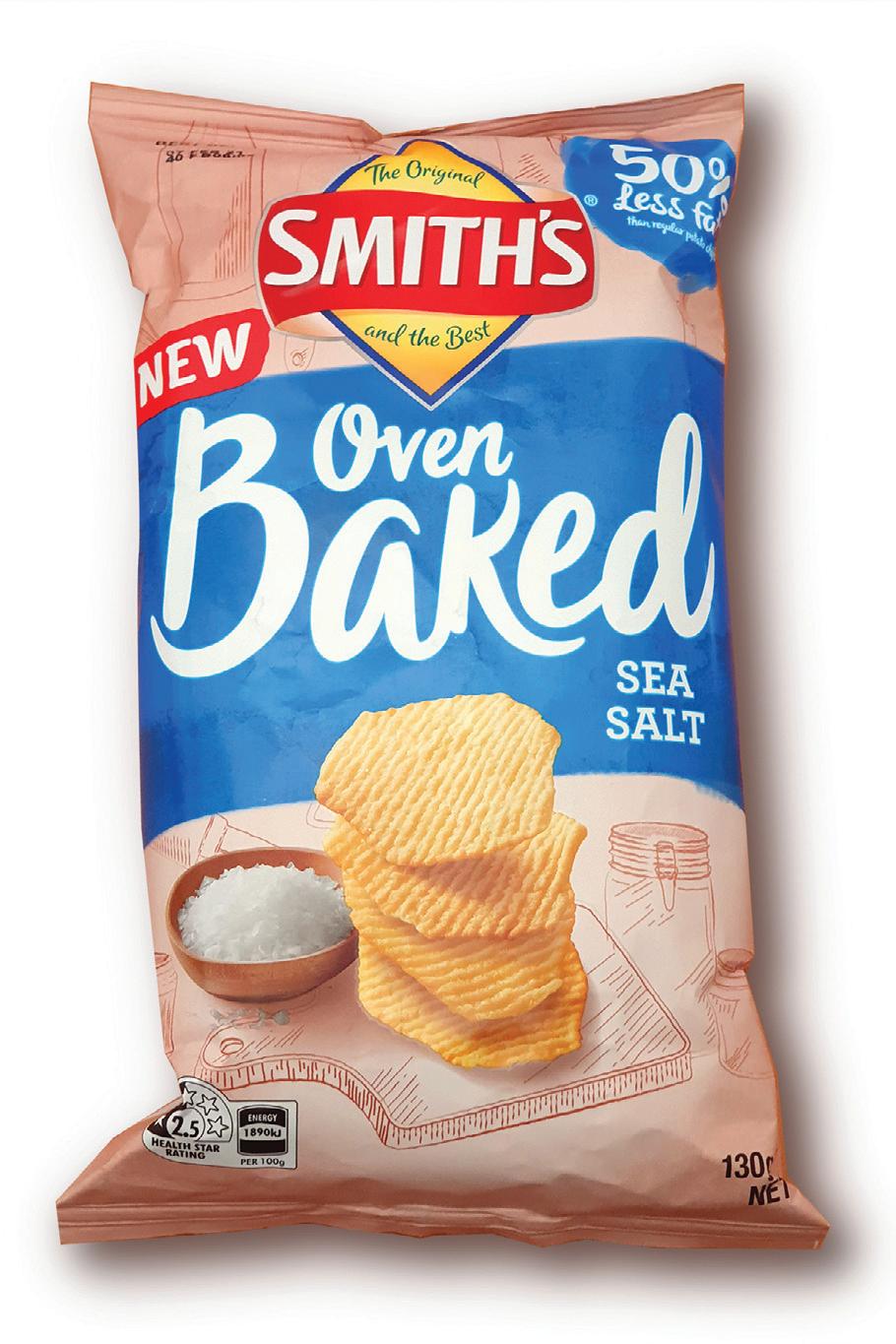
13 minute read
Smith’s Snackfoods installs large-scale bulk handling system for new chip line
Smith’s Snackfoods
installs large-scale bulk handling system for new chip line
The Smith’s Snackfood Company began manufacturing potato crisps (chips) in Australia in 1931 and was the first to offer flavoured crisps in Australia. Today, as a unit of US-based PepsiCo, its brands include Twisties, Burger Rings, Doritos and Parker’s pretzels, as well as reduced-fat products such as Sakata rice cakes, and Sunbites Grain Waves whole grain chips and Sunbites air popped popcorn.
In January 2019, Smith’s installed a process line to manufacture Smith’s Oven Baked potato chips, which contain 50% less fat and have been designed to have more crunch and texture than traditional fried crisps.
For the powder handling and blending portion of the new line, Smith’s worked with Flexicon Corporation Australia. Due to the size and scope of the new system, the supplier’s Project Engineering Division (PED) handled much of the design and specification work.
The new powder handling and blending system consists of two upstream batch processes that feed a downstream continuous process.
In one batch process, major ingredients received in bulk bags are dispensed by weight from two Bulk-Out model BFC bulk bag dischargers supplied by Flexicon. Installed facing one another, the matching dischargers are each equipped with an electric hoist and trolley that travel on an I-beam common to both frames, allowing bulk bags to be loaded from a single floor location.
The dischargers are each equipped with a Spout-Lock clamp ring atop a Tele-Tube telescoping tube that applies continual downward tension as the bag empties and elongates, directing material through the bag spout. The sealed systems of both dischargers are vented to a dust collection system installed in an adjacent room, preventing contamination of the plant environment.
Flow-Flexer bag activator plates raise and lower opposite bottom edges of the bags on timed cycles, ultimately forming a steep ‘V’ shape that promotes total discharge. Both are also equipped with a Power-Cincher flow control valve in which contoured stainless steel rods cinch the bag spout concentrically, allowing dust-free retying of partially empty bags.
When a batch is initiated, the rotary airlock of either discharger begins metering material into a common pneumatic conveying line leading to a Flexicon filter receiver suspended on load cells. Weight gain information is transmitted to the system controller that runs the airlock valve at high speed, then at dribble feed rate which, together with programmatic compensation for material in-flight, achieves precise batch weight accuracy.
Once major ingredients are batched in sequence from bulk bags, pre-weighed sacks of low-volume ingredients are positioned using a 25 kg vacuum sack lifter, and dumped manually through a Flexicon bag tip station with integral dust collector and rotary airlock valve feeding the same pneumatic conveying line. A chute through the sidewall of the bag dump hood leads to a Flexicon bag compactor with pneumatic ram that compresses up to 150 bags into a plastic-lined container for dust-free disposal.
The batch accumulated in the filter receiver is then gravity discharged into a paddle mixer. Blended batches are discharged into a Flexicon buffer hopper that is sized to provide a continuous supply of material to the downstream process through a second pneumatic conveying system and filter receiver.
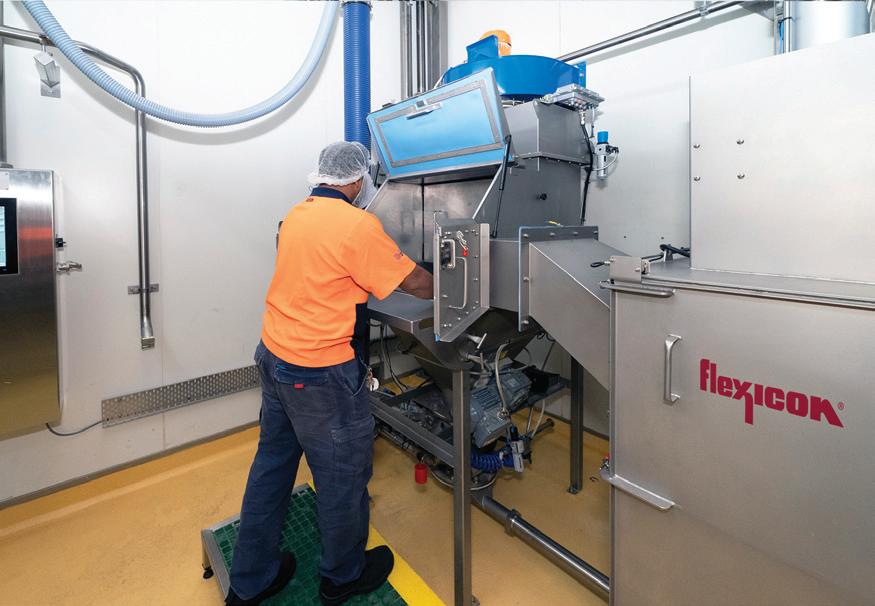
©stock.adobe.com/au/xamtiw
In a separate batch process, a Flexicon bag tip station — also with integral dust collector, compactor chute and rotary airlock valve — is dedicated to manual additions of pre-weighed, premixed inclusion ingredients. Positioned adjacent to the first bag tip station, it shares the same bag compactor, but meters material into a third pneumatic conveying system and filter receiver.
The second and third filter receivers are suspended on load cells that signal the system controller when to convey additional blended material from the buffer hopper, and from the second bag dump station respectively. These rotary airlock valves provide material on an as-needed basis to a pair of loss-in-weight (LIW) gravimetric feeders, which allow rapid changing of screws to suit material flow characteristics, at throughputs from 4 to 400 kg/h. The overall arrangement allows the LIW feeders to provide an uninterrupted supply of material to a new continuous mixer at precise ratios and rates, completing the powder handling and blending portion of the new Oven Baked potato chips line.
Managing lockdowns and logistics
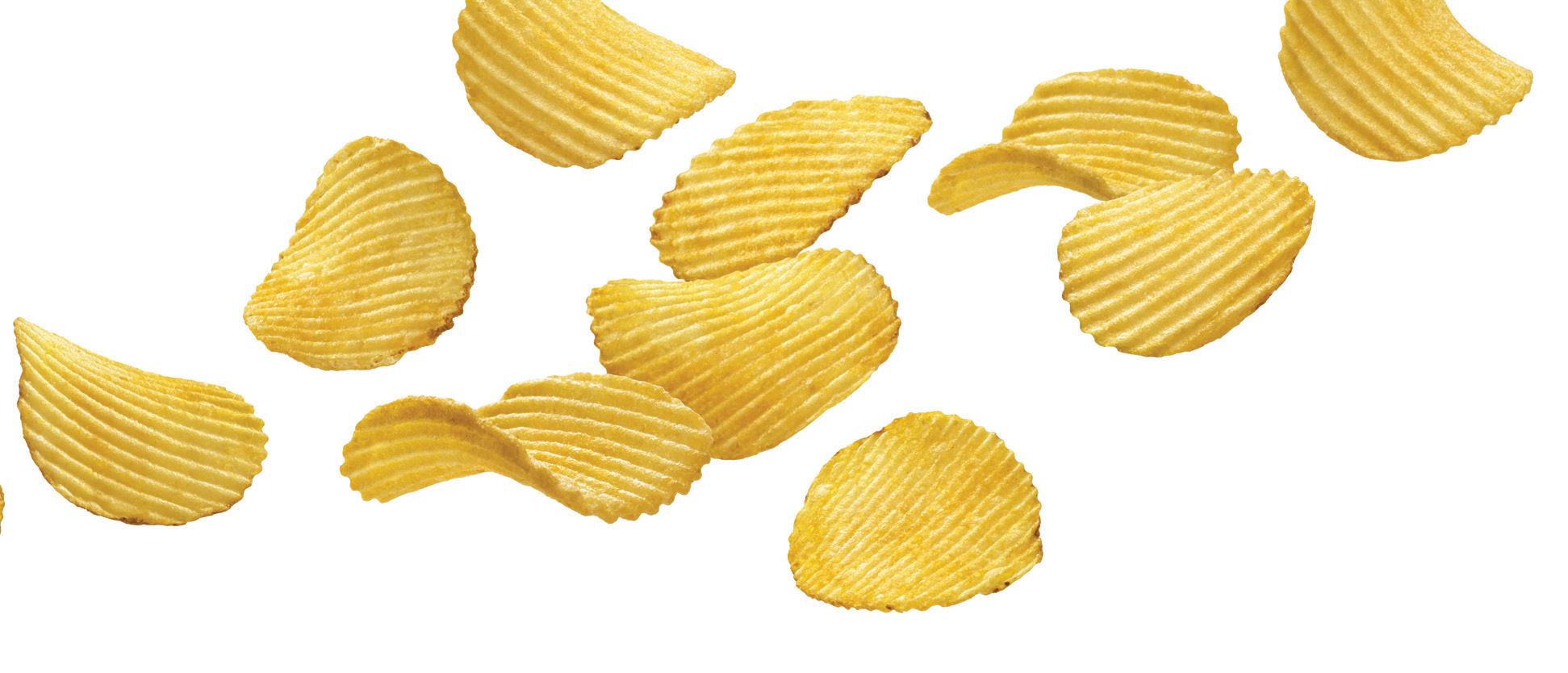
Flexicon’s Project Engineering Division recommended equipment specifications, coordinated multiple equipment manufacturers and developed a controls and automation package for the bulk handling system that integrates with Smith’s overall process control system. For parts to be imported, the supplier obtained special exemptions to COVID-19 restrictions on crossing state borders.
“We had an aggressive schedule to get the new production line installed and commissioned on time and we ran into numerous challenges as a result of the COVID-19 pandemic,” said Nayantha Abeysiri, PepsiCo project manager. “However, Flexicon found solutions to those challenges while staying on budget to get the equipment manufacturing completed on schedule.
“The equipment design is efficient, hygienic, simple, and meets all EHS requirements and food safety standards,” he said, adding that Flexicon is in the design phase for another project.
Flexicon Corporation (Aust) Pty Ltd www.flexicon.com.au
BULK HANDLING, STORAGE & LOGISTICS
Bulk bag dischargers meter major ingredients by weight into a pneumatic line. Bags are inserted and removed using a cantilevered I-beam, hoist and trolley.
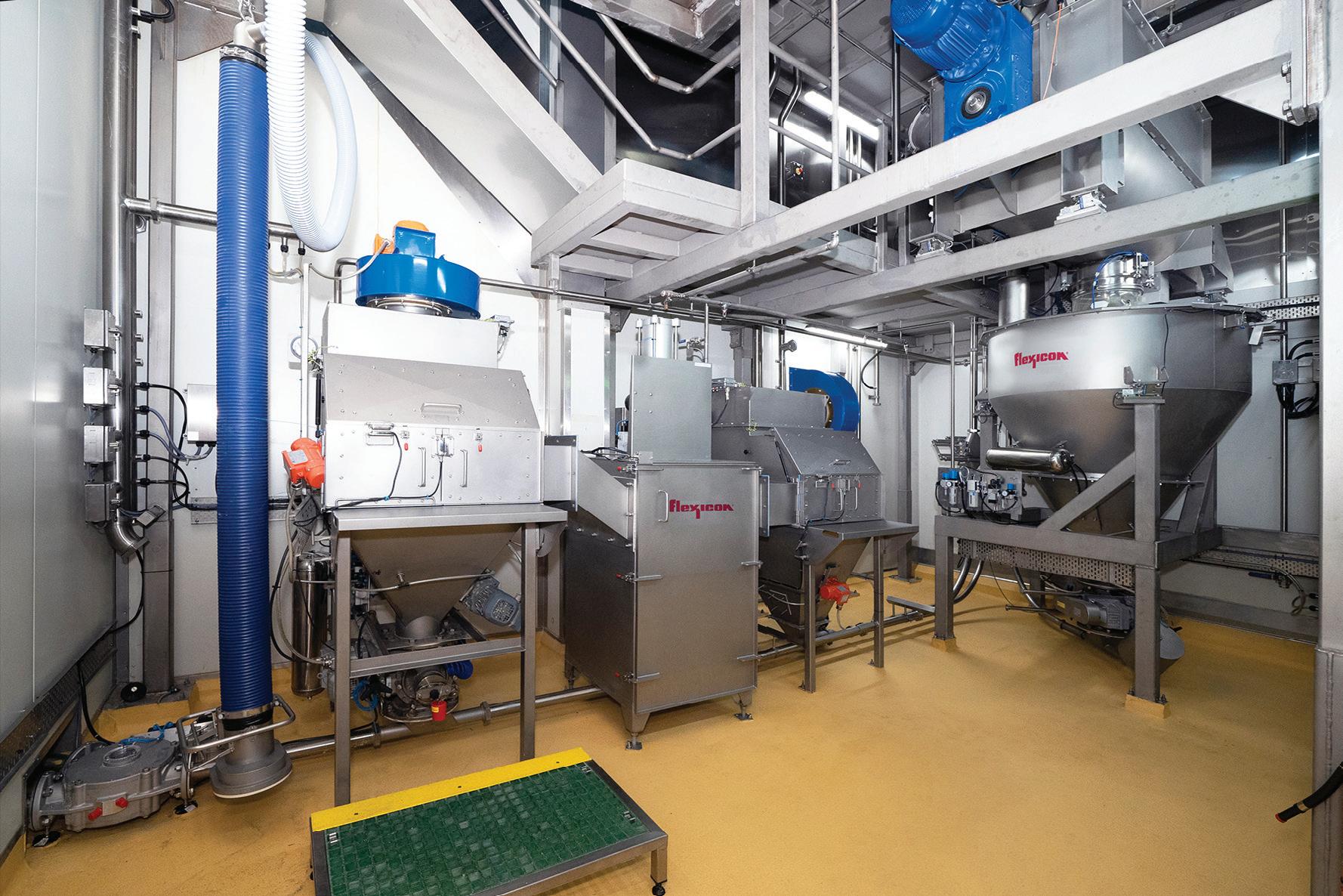

CASE STUDY
Lactalis Australia increases AGV fleet
Building on its initial deployment of four Dematic automated guided vehicles (AGVs), Lactalis Australia, part of global dairy producer Lactalis, has invested in an additional AGV for its fleet at its Lidcombe Milk Site in NSW.
With the addition of a fifth AGV to operations, Lactalis is now able to expand automation to more areas within the warehouse. All five AGV units will work cohesively together, with the flexibility for each of them to operate within different areas of the warehouse to retrieve products ready for dispatch.
“Dedicated to investing in and growing the Australian dairy industry, as well as promoting Australia as a high-quality producer for the Asia–Pacific region, this transition into sitewide automated operations with AGVs has helped Lactalis to significantly streamline our operations,” said Kristian Brennan, National Logistics Optimisation Manager at Lactalis. “After already experiencing major improvements to productivity with our initial adoption of Dematic’s AGVs in 2019, this new addition to the fleet will allow us to further automate our operations in both inbound and outbound zones within the warehouse.”
The fleet of AGVs works to retrieve pallets from an inbound conveyer system from production, and then feed the pallets into an order buffer, releasing the pallets at a declined angle onto pallet live storage racking. AGVs are capable of operating 24/7 in both small and large spaces and managing tight traffic at speeds of up to 1.7 m per second.
The AGVs manage the transportation of pallets of milk at the Lidcombe site and are capable of lifting loads of up to 1.2 tonnes to a height of six metres. Additionally, the AGVs are well suited to working at the site’s chilled environment, which has a temperature of just 2 to 4°C.
AGVs are an innovative automated solution that use sensors and laser scanners to navigate with precision for safety around workers and any obstacle. They are powered by lithium-ion batteries and can drive themselves onto charging floor plates at times of inactivity to be fully charged in just 2 h.
“Lactalis is a fast-growing company in Australia, and now with a complete fleet of AGVs, they are able to automate several areas of the warehouse, which allows them to optimise picking and dispatch operations across the board,” said Tony Raggio, General Manager AGVs at Dematic.
Dematic Pty Ltd www.dematic.com.au

Mobile industrial robot
Konica Minolta Australia has announced the availability of the MiR250 mobile industrial robot, through its partner Mobile Industrial Robots (MiR).
Simple to set up, the autonomous mobile robot (AMR) has a smaller footprint and increased adaptability. This can help to optimise internal logistics without changing layout in industries such as manufacturing, FMCG and defence.
With a footprint of 580 x 800 mm, the AMR is only 30 cm high and can move up to 250 kg at speeds of 2 m/s.
The AMR also has a fast charge rate of 0–80% in 1 h with an operating time of 13 h at full charge, and has the ability for a fast battery swap to support 24/7 operation.
Top modules can also be mounted on the robot to provide a complete solution to tow carts and shelves and lift and transport shelves.
The AMR signals with light and sounds to demonstrate its status. The LED light band indicates its current operational state such as emergency stop, mission paused, path blocked or mapping. It also has signal lights that work similarly to lights used on cars: white at the front, red at the back and indicating a left or right turn by blinking. Signal lights suggest the immediate motion plans by signalling forwards, backwards, braking and left and right turns.
Konica Minolta Business Solutions Australia Pty Ltd
www.konicaminolta.com.au
SteriFloor addresses issues around antimicrobial surfaces in manufacturing
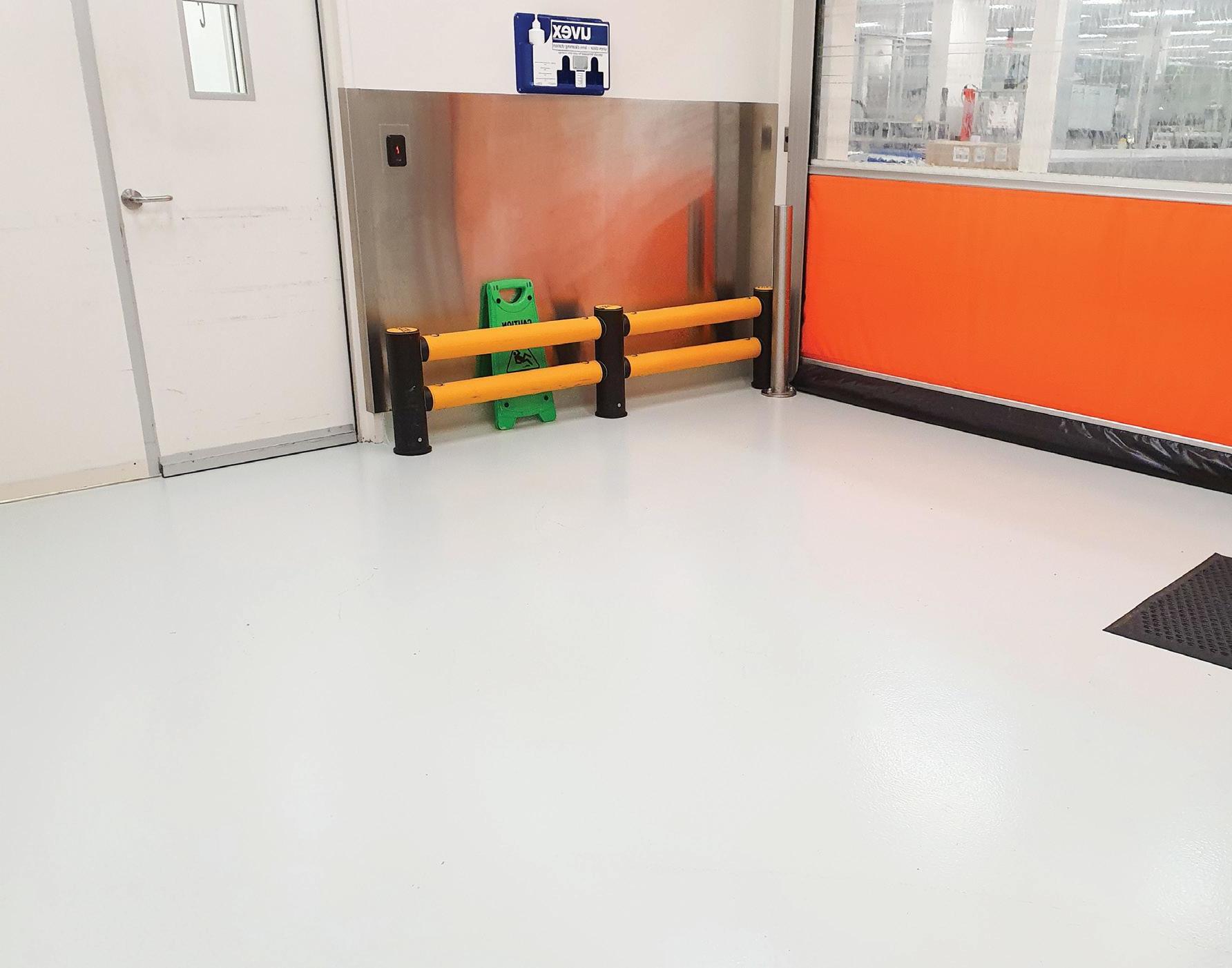
Flooring specialists, Allied Finishes, have spent the past two years working on a new product that sterilises production fl oors without creating a slip hazard — SteriFloor.
Allied Finishes recently received an ISO 22196 certifi cation for SteriFloor, the new antimicrobial suite of fl ooring solutions developed by the company.
The ISO 22196 certifi cation specifi es a method of evaluating the presence bacteria on antibacterial-treated plastics and other product surfaces and requires a standard review every fi ve years.
A few key factors make the certifi cation of extra value to those who obtain it, fi rstly the method is quantitative so the results can be reproducible, which in turn should increaser confi dence in the product.
The method, which is quite fl exible, also tests for both growth inhibiting bacteria and bacteria-killing properties in the product.
SteriFloor was designed to create an antimicrobial surface in food and beverage manufacturing while adhering to WHS by not creating a slip hazard, something which plagued earlier attempts.
Allied Finishes suite of solutions is currently at six since completing the research and development phase with the help of scientists and a willing client.
The new surface solution combats bacteria build up while mitigating slipping hazards.
While fl ooring is recognised as being passively antimicrobial because bacteria growth isn’t made easier, the fl oors don’t necessarily actively combat it, until now.
A research intern, Jayanti Arun Mendhi, joined the company in 2021 to analyse and test the range against current fl ooring.
The client agreed to take part in the testing and Mendhi visited the site on two occasions to better understand the problems which needed solving.
“I had informative conversations with the clients to explain to them how antimicrobial coatings work and how improvements in technology could benefi t their factories,” said Mendhi.
“The two main objectives were to improve on existing coatings with antimicrobial properties by testing coatings prepared with antimicrobial technology, and secondly to research about problems faced by the food industry in relation to fl oorings, identify some of the less commonly understood problems and suggest improvements.”
Through her research Mendhi confi rmed SteriFloor was among the best antimicrobial technology on the market.
As well as testing the product against competitors, Mendhi also conducted microbial tests comparing a SteriFloor sample to an untreated polyethene cement sample.
“The existing antimicrobial coatings were tested by ISO standard tests and relevant reports were prepared,” said Mendhi.
“Along with this, microscopy imaging was done to visualise samples with and without bacteria to better understand the existing and optimised products.”
Mendhi then prepared an educational report on her fi ndings for the clients to better understand its advantages.
“Along with this, factory visits to the food factories assisted in understanding the needs of the clients and the problems faced by them in the food factories,” said Mendhi.
“Extensive research was done through research databases to acquire more knowledge about some of the less commonly understood problems of the food industry.”
The result which helped seal the release of SteriFloor came when, after two years, a site which employed the technology saw no bacteria growth on its fl oors for the entire duration.
This created confi dence in SteriFloor solving a problem which has plagued the industry for some time.

Allied Finishes www.alliedfi nishes.com
CASE STUDY
Nut processing facility improves yield using new sorter

US food manufacturer, Caro Nut Company, processes and packages a variety of dry roasted, oil roasted or pasteurised raw snacking nuts, nut butters and ingredients for major brands, private label customers and industrial food processors.
Caro Nut recently selected Key Technology’s VERYX BioPrint sorter for its nut butter line. The new technology is designed to remove more shells, foreign material (FM) and product defects, all while increasing yield.
Gerard Lorenzano, Plant Manager at Caro Nut said: “Before we replaced our old sorter, we had to sacrifice a lot of good nut meat in order to get the shells out. It took a lot of time and effort to re-sort the rejects and recover yield.
“All that changed with our new sorter. VERYX BioPrint removes exactly what we want and nothing more... This powerful technology has improved our product quality at the same time it’s increased our yield by more than one metric ton of product a day.”
Combining hyperspectral imaging with colour cameras, the sorter is designed to inspect across a range of wavelengths within the near infrared (NIR) spectrum as well as visible light to analyse a richer data set about the materials it’s sorting. Data from the hyperspectral sensors and colour cameras is fused at the pixel level using Key’s Pixel Fusion technology, producing a unique ‘signature’ for each material substance to detect the chemometric and biologic properties of objects. The nut sorter finds and removes a wide variety of FM and even hard-to-detect defects, such as nuts with insect damage, rot and mould, without false rejects, regardless of incoming defect loads, while also shape sorting and colour grading.
“Detecting shells is difficult for traditional laser/camera sorters because, when shells are the same colour as good nut meat, it can trick the sensors. VERYX BioPrint uses hyperspectral technology to look at the moisture content of objects. It sees low moisture in shells and kicks them out,” explained Sonny Chhina, Maintenance Supervisor at Caro Nut. “This sorter is so effective, we’ve eliminated manual inspection on the line and moved that person to elsewhere in our plant.”
“We’re able to handle heavier loads of incoming shells and defects with this hyperspectral sorter,” Chhina added. “We start by selecting the product recipe from the sorter’s memory. If the incoming load is very heavy, we may need to adjust the sensitivity of the settings a little, but that’s easy to do with just a couple of taps on the touchscreen. Then we’re good to go.”
Caro Nut’s VERYX BioPrint C140 features front- and rearmounted hyperspectral sensors and high-resolution colour cameras. It can sort up to eight metric tons of cashews, almonds, macadamia nuts and other nuts per hour.
“We’ve connected our VERYX BioPrint to our plant network, which is a great asset for us,” Chhina noted. “If we reach out to Key for support, they’re able to jump on and work with the sorter remotely to help us maintain peak performance.
“We’re tapping into VERYX’s data collection capability as well. For example, our sorter is programmed to measure the attributes of the incoming product and its reject stream. We use that information to be sure we’re ejecting exactly what we want to remove. We also give that data to our source managers so they can negotiate supplier payments based on incoming product quality.” Key Technology Australia Pty Ltd www.key.net










